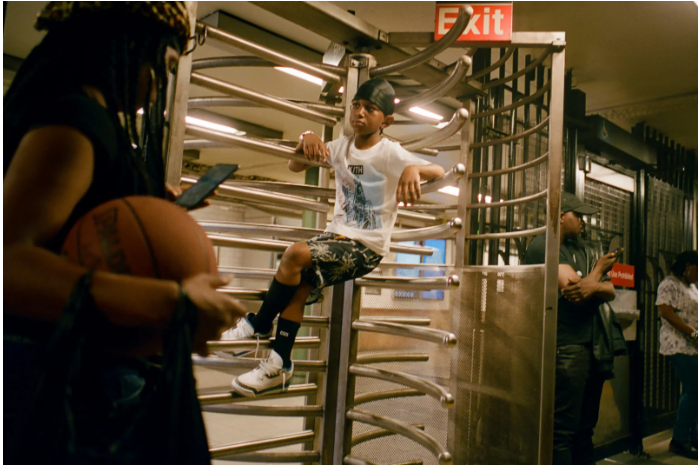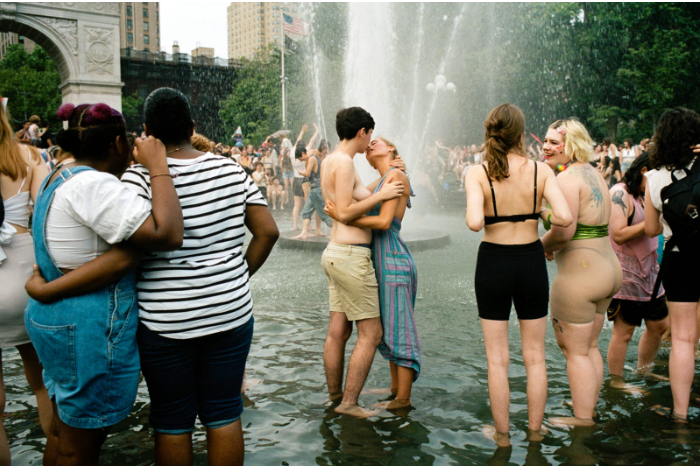Photographer Daniel Arnold’s Lightning-Quick Sensibility Yields Moments of Humanity and High Weirdness
Some moments are so confoundingly odd you would swear that digital manipulation was involved. This is not the case. Mr. Arnold deals purely with analog reality in each chromogenic print.

Daniel Arnold: ‘New York Life’
New York Life Gallery, 167-169 Canal Street, 5th Floor, New York, NY
Until December 22nd
The photographer’s eye is an elusive, almost mystical talent prized since the first quick exposures. With the passing of static portraits, the fluid and handheld positioning of the photographer became of central, even existential importance. Photographers became mobile, an inquisitive presence interpolating themselves into humanity.
Daniel Arnold is the epitome of such an eye. Not since André Kertész have we witnessed such a lightning-quick sensibility, able to frame the arresting and the uncanny in an instant. Restlessly scouring the New York streets, he snaps people pushing through the crowded sidewalks, ordering food from push carts, sprawling in parks or near the river, or simply marking time on stoops.
Some moments are so confoundingly odd you would swear that digital manipulation was involved. This is not the case. Mr. Arnold deals purely with analog reality in each chromogenic print. And each print is quintessential New York City.
The moments Mr. Arnold captures should rightfully belong to any citizen with a cellphone. After seeing a few shots, however, it becomes obvious that his magic eyes do not reside in our skulls. Mr. Arnold produces instances of humanity and high weirdness with the glib facility of a stage magician. Synchronicities and odd details pierce through the mundane with a glimmer of alchemical magic. Daniel Arnold is the real deal.

“135th and Lennox” shows us a boy, no more than eight, in a revolving turnstile gate in a do-rag. Except that he is casually suspended on the bars halfway up as he rotates through, seemingly suspended in mid-air.
“Grand and Essex” confronts us with a man’s lumpen and shirtless brown torso — shown only from the neck down. Tattoos saying “Live, Laugh, Love” and “Be happy” are visible, along with a weapon of some sort on the waist band of his jeans. Mr. Arnold obviously enjoys the tense push and pull of these visual contrasts. There are layers of paradox and contradiction in what New Yorkers present to the world, and he exploits them fully.
Sometimes the irony can be political, even metaphysical. In “46th and 7th Avenue” we see a woman in full niqab and sunglasses, sitting on a concrete divider under a digital billboard that says “Visiting the US?” Mr. Arnold is merely a witness, and leaves us to read between the lines.
In “Coney Midway,” a young redhead in a snake-print mini skirt bends to adjust a scarlet heel. Behind her, in a glass case, the figure of death appears to be leering at her directly through glowing red eyes. Mr. Arnold frames the midway as a parable of alluring young womanhood and death, with all its attendant resonances.
Other juxtapositions carry some freighted symbolic weight. “Forsyth and Division” presents an African-American woman whose lower face appears to be white. It is a silk-screened face mask of a white woman’s mouth and chin. “East River Ferry (Brooklyn Bridge)” gives us the glimpse of an individual — man or woman? — from behind, holding up a pocket mirror. We see a small square of his or her reflection framed in red against the panorama of the bridge and the other passengers. It broadcasts just enough intrigue to keep you guessing.

There are also moments of genuine tenderness, though Mr. Arnold could hardly be described as a romantic. In “Washington Square Park (fountain)” a young couple hovers on the edge of a kiss during a sweltering summer heat wave. With the fountain spraying behind them, ensconced at the images center, it elevates them to the level of icons. “Central Park (Sheeps Meadow)” captures another moment of intensely personal tenderness cinematic in its intensity.
It’s telling that the titles of Mr. Arnold’s prints are neutral. He only gives street intersections, nothing more, so that the human content he has captured is left to speak for itself. He also demonstrates how the people of New York are inseparable from its streets, existing in a surprising and unpredictable symbiosis with each locale. With his unfailingly quick and quirky eye, Mr. Arnold has succeeded in capturing the fleeting and mercurial enchantment of New York streets. It’s no mean feat.

